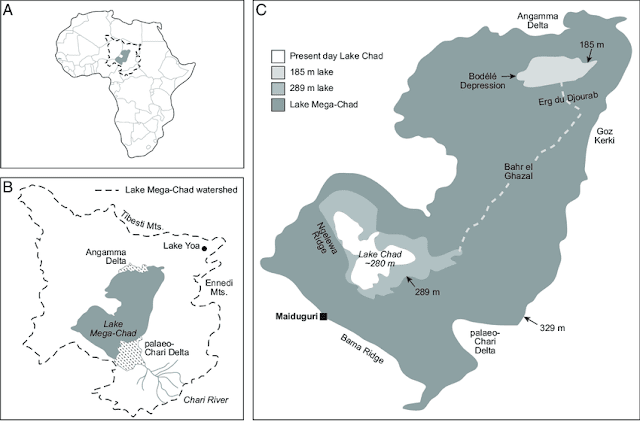Lake Mega-Chad and the African Humid Period
In my last post I discussed environmental change in the Lake Chad Region in comparison to that of Lake Victoria, the largest lake in Africa. What is even more startling than the comparison between Lake Chad and Lake Victoria is the comparison between the current extent of Lake Chad and Lake Mega-Chad (LMC).
Figure 1: Location maps of Lake Chad. (B) shows Lake Mega-Chad's catchment and (C) shows the extent of present-day Lake Chad (as of 2015) compared to Lake Mega-Chad.
Source: Armitage et al. 2015
Source: Armitage et al. 2015
The surface area of LMC is thought to have exceeded 350,000km2, a similar area to that of the Caspian Sea, currently the largest lake on earth (Bouchette et al. 2010). LMC was the largest Quaternary body of water on the African continent. The extent of LMC is thought to have peaked around 6,000 years ago at the end of the African Humid Period. Figure 1 shows that extent of LMC compared to its basin and the current extent of Lake Chad.
The African Humid Period (AHP)
The African Humid Period (AHP)
Humid conditions began approximately 15,000 years ago (Armitage et al. 2015). By between 10,000 and 11,000 years ago, precessional forcing caused summer insolation in the Northern Hemisphere to peak at levels 8% higher than today (deMenocal et al. 2000). The AHP lasted from between 9,000 and 6,000 years ago and the greening of northern Africa is thought to be a result of the intensification of the African Monsoon caused by orbital forcing (deMenocal et al. 2000).
The AHP abruptly ended around 5,000 years ago and the northern basin of LMC became dry 4,000 years later (Armitage et al. 2015). Some hydrologists suggest that the end of the AHP was caused by a gradual aridification in response to precessional forcing (Collins et al. 2017). As well as LMC, there were a number of other megalakes including Megalake Fezzan, Libya, Chotts Megalakes, Algeria and Megalakes Turkana and Kenya (deMenocal and Tierney 2012). Stratigraphic records suggest that during the AHP, annual moisture supply must have exceeded annual evaporation as these lakes are thought to have been permanent and open-basin (deMenocal and Tierney 2012).
Other evidence for the AHP comes from the Nile and Niger river drainage basins which both showed increased outflow into the Mediterranean and Atlantic oceans respectively (deMenocal and Tierney 2012). In East Africa, Lake Tanganyika’s hydroclimatic records suggest that the AHP started and ended abruptly over only a few centuries and this is corroborated by deep sea dust sediments off the Northwest African coast. Figure 2 shows that lake level during the AHP across much of Africa was higher than today. LMC and its characteristics represent a very different African environment to the one in which Lake Chad exists in now and the AHP demonstrates the dramatic environmental change which affected water availability in Africa. Evidence for the AHP is widespread and exemplifies the impact such environmental change can have on water in lakes, rivers and oceans.




Hi Eilish, I thought the comparison between current Lake Chad and Lake Mega-Chad was shocking! Do you think future changes in climate could affect some of our larger lake today in the same way changes in climate since the AHP have affected Lake Chad?
ReplyDeleteAs Figure 2 shows, lake level has fallen over much of Africa since the AHP and so it is possible that over a longer timescale, the changes occurring in the Lake Chad Region could also occur across Africa.
Delete